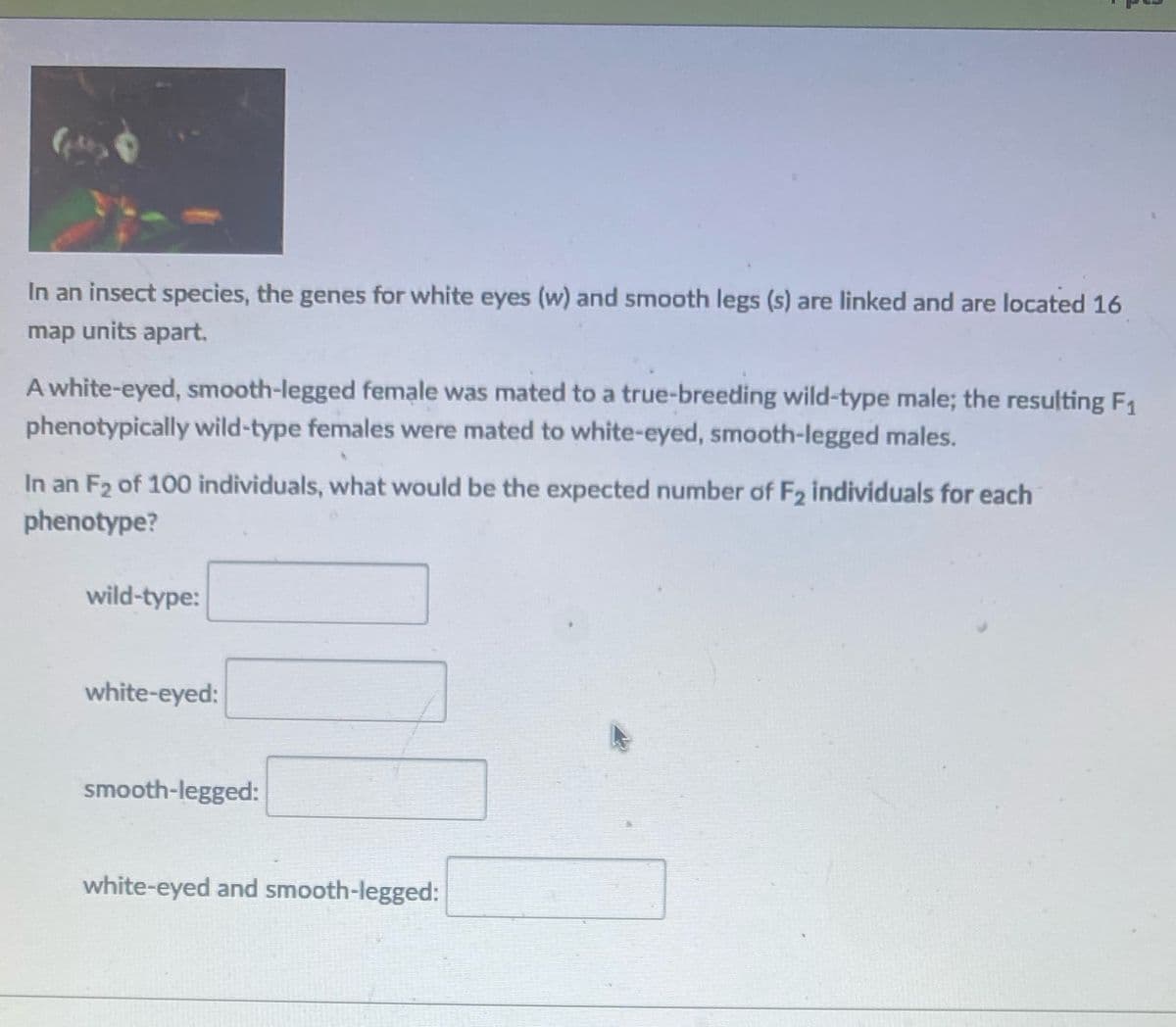In an insect species, the genes for white eyes (w) and smooth legs (s) are linked and are located 16 map units apart. A white-eyed, smooth-legged female was mated to a true-breeding wild-type male; the resulting F1 phenotypically wild-type females were mated to white-eyed, smooth-legged males. In an F2 of 100 individuals, what would be the expected number of F2 individuals for each phenotype? wild-type: white-eyed: smooth-legged: white-eyed and smooth-legged:
In an insect species, the genes for white eyes (w) and smooth legs (s) are linked and are located 16 map units apart. A white-eyed, smooth-legged female was mated to a true-breeding wild-type male; the resulting F1 phenotypically wild-type females were mated to white-eyed, smooth-legged males. In an F2 of 100 individuals, what would be the expected number of F2 individuals for each phenotype? wild-type: white-eyed: smooth-legged: white-eyed and smooth-legged:
Human Anatomy & Physiology (11th Edition)
11th Edition
ISBN:9780134580999
Author:Elaine N. Marieb, Katja N. Hoehn
Publisher:Elaine N. Marieb, Katja N. Hoehn
Chapter1: The Human Body: An Orientation
Section: Chapter Questions
Problem 1RQ: The correct sequence of levels forming the structural hierarchy is A. (a) organ, organ system,...
Related questions
Topic Video
Question

Transcribed Image Text:In an insect species, the genes for white eyes (w) and smooth legs (s) are linked and are located 16
map units apart.
A white-eyed, smooth-legged female was mated to a true-breeding wild-type male; the resulting F1
phenotypically wild-type females were mated to white-eyed, smooth-legged males.
In an F2 of 100 individuals, what would be the expected number of F2 individuals for each
phenotype?
wild-type:
white-eyed:
smooth-legged:
white-eyed and smooth-legged:
Expert Solution
Step 1
In genetics, genes forms the hereditary units of life. The genes contains two alternative forms called alleles. When similar alleles are present, it is called homozygous conditions and when dissimilar alleles are present, it is called as heterozygous conditions.
Step by step
Solved in 3 steps with 1 images

Knowledge Booster
Learn more about
Need a deep-dive on the concept behind this application? Look no further. Learn more about this topic, biology and related others by exploring similar questions and additional content below.Recommended textbooks for you

Human Anatomy & Physiology (11th Edition)
Biology
ISBN:
9780134580999
Author:
Elaine N. Marieb, Katja N. Hoehn
Publisher:
PEARSON

Biology 2e
Biology
ISBN:
9781947172517
Author:
Matthew Douglas, Jung Choi, Mary Ann Clark
Publisher:
OpenStax

Anatomy & Physiology
Biology
ISBN:
9781259398629
Author:
McKinley, Michael P., O'loughlin, Valerie Dean, Bidle, Theresa Stouter
Publisher:
Mcgraw Hill Education,

Human Anatomy & Physiology (11th Edition)
Biology
ISBN:
9780134580999
Author:
Elaine N. Marieb, Katja N. Hoehn
Publisher:
PEARSON

Biology 2e
Biology
ISBN:
9781947172517
Author:
Matthew Douglas, Jung Choi, Mary Ann Clark
Publisher:
OpenStax

Anatomy & Physiology
Biology
ISBN:
9781259398629
Author:
McKinley, Michael P., O'loughlin, Valerie Dean, Bidle, Theresa Stouter
Publisher:
Mcgraw Hill Education,

Molecular Biology of the Cell (Sixth Edition)
Biology
ISBN:
9780815344322
Author:
Bruce Alberts, Alexander D. Johnson, Julian Lewis, David Morgan, Martin Raff, Keith Roberts, Peter Walter
Publisher:
W. W. Norton & Company

Laboratory Manual For Human Anatomy & Physiology
Biology
ISBN:
9781260159363
Author:
Martin, Terry R., Prentice-craver, Cynthia
Publisher:
McGraw-Hill Publishing Co.

Inquiry Into Life (16th Edition)
Biology
ISBN:
9781260231700
Author:
Sylvia S. Mader, Michael Windelspecht
Publisher:
McGraw Hill Education